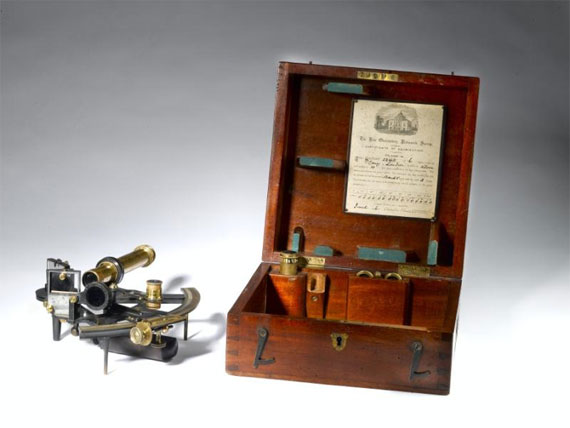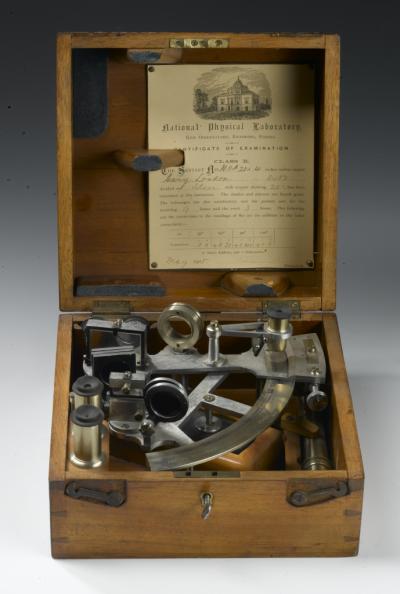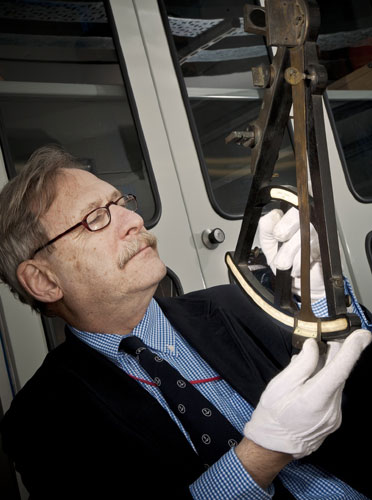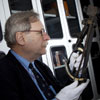Dr Mörzer Bruyns has been working with our Science and Technology department on cataloguing our nautical instrument collection.
The collection of the National Museums Scotland in Edinburgh contains 149 cross-staffs, backstaffs, octants, sextants, quintants and artificial horizons; navigational instruments dating from between 1684 and the 1970s. In quality and quantity this section of the collection ranks at about the same level as the Science Museum in London.
Early instruments
The oldest navigating instrument in the Edinburgh collection is a Dutch cross-staff dated 1684. Cross-staffs were used at sea from the beginning of the sixteenth till the end of the eighteenth century, to measure the altitude of the sun or the Pole star above the horizon. With the altitude, and a nautical almanac, a seaman could calculate his latitude. Johan Sort of Amsterdam made this cross-staff; he was active as a manufacturer in the 1680s. As often is the case, the crosses have gone missing, and the staff was given a second life as a yardstick. It now has brass caps at either end stamped ‘C F Fife 1835’, a Fife verification mark introduced that same year.
The collection also contains two eighteenth-century backstaffs; instruments that like the cross-staff were used for altitude-measurement at sea. Benjamin Macy of London made one of them in 1726, for Captain William Cochren.

Octants
An octant is a double-reflecting instrument for measuring the altitude of a celestial body above the horizon; it was invented in London in 1731, and was a significant improvement over the cross-staff and backstaff. Edward Nairne in London made one of the early examples in the Museum’s collection, in 1774; another is by James Chapman, St Catherine’s in London. That is dated 1788, and was made for Captain John Race.

Most of the octants in the Museum date from the nineteenth and twentieth century. Dickie and Co in Troon sold an interesting example with a brass frame; it was made around 1900. Its scale is engraved in ivory and inlaid in an ebony rim that was then slid in the limb of the brass frame.
Sextants
Cary in London made two of the Museum’s sextants (an octant but with its arc extended from 90 to 120 degrees) in the 1890s; both have an early micrometer. With a micrometer a scientific instrument can be read more easily and quickly than by the traditional vernier. The micrometer was designed in the seventeenth century, and Jesse Ramsden of London was the first manufacturer to apply such a device to a sextant, in the 1780s. The problem with early micrometers was that there was no locked-in position between it and the arc. Carl Plath, sextant maker in Hamburg, Germany, solved this with his drum sextant, brought on the market around 1906.

Instruments for hydrographic surveying
The Museum has a number of surveying instruments, for use by naval hydrographers. Alexander Adie in Edinburgh made two box sextants for surveying, both dating from around 1825. They have an unusual feature, a clamping screw and a tangent screw on their index arms that are uncommon on a box sextant.
Around 1892 Henry Hughes and Son in London developed a simple, easy to use surveying sextant that they called ‘Paget Angle Sextant’. It was held horizontally to measure the angle between two points on shore, in hydrographic surveying. The Museum also has two examples of what appears to be the ‘Paget’s’ predecessor: Hughes’s ‘Angle Sextant’.
Polar expeditions
Cary in London made the two quintants (a sextant with its arc extended to 150 degrees) with aluminium frames for the Hydrographic Office of the Admiralty, to be taken on the British Antarctic Expedition of 1901-04, the Discovery Expedition. Both are now in the Museum’s collection. Aluminium was patented for making nautical and other scientific instruments in 1861, but most aluminium sextants and quintants are of later date. Aluminium weighs about one-fifth of brass which is a great advantage on expeditions, where every kilogram counts.

World War II
Later sextants in the collection include a number of bubble sextants that were made by Henry Hughes and Son in London during World War II, for use on aeroplanes of the RAF and the Fleet Air Arm of the Royal Navy. For security reasons they did not bear the manufacturer’s name, by simply the initials ‘A. M.’ for Air Ministry.
Later Sextants
In the 1960s East German sextants like the one made by Freiberger Präzisionsmechanik, in Freiberg, Saxony (then in the German Democratic Republic) became popular in the West. The Freiberg manufacturer was a subsidiary of the Zeiss instrument factory in Jena. East German sextants were light in weight (an advantage in use), reliable, easy to use, and cheap, and thus they contributed to the downfall of the British sextant industry.
The most recent acquisition in this section is a Periscopic aircraft bubble sextant, that was made by Kollsman Instrument Corporation in Elmhurst, NY, USA; it comes from a recently de-commissioned Nimrod aeroplane.

Provenance
Private individuals, such as former seamen or their descendants, donated a number of the navigational instruments to the Museum. A considerable number – especially for surveying – came from the Hydrographic Office of the Admiralty. Many of the Scottish-made or retailed octants and sextants were acquired from Arthur Frank (1915-2005), a successful Glasgow businessman and collector of historic scientific instruments.
Finally, Leith Nautical College, on its closure in 1987, donated nineteen octants, sextants and artificial horizons. The College had been founded in 1855 and over the years old pupils and retired seamen gave their navigational instruments to the school, to be used as teaching tools in navigation classes.
